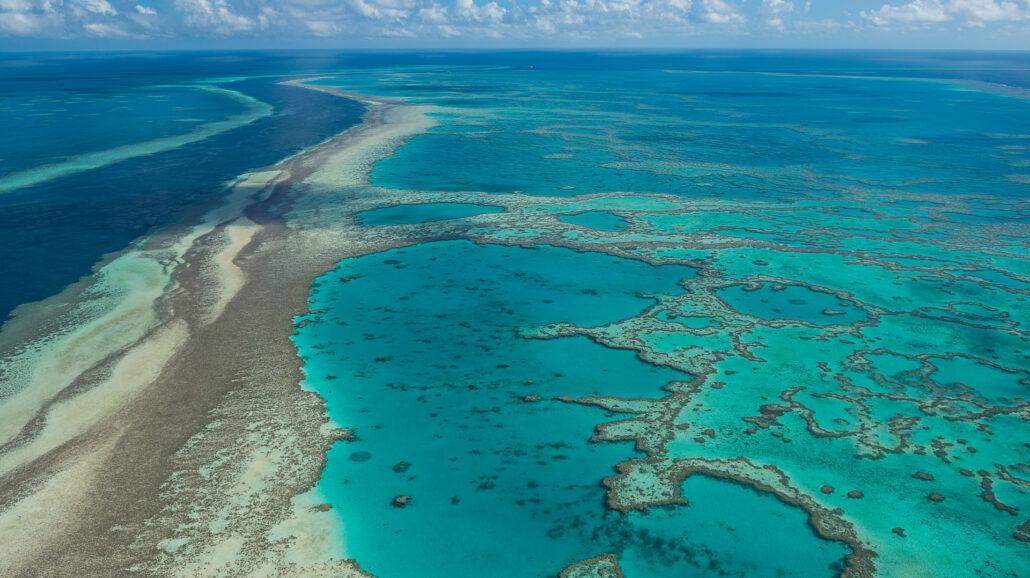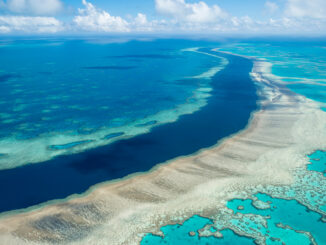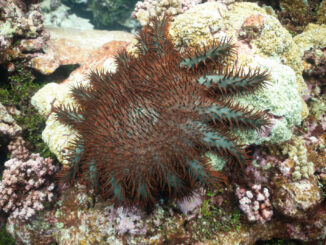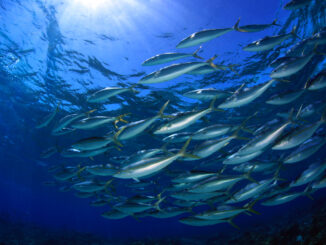
The planet’s largest coral reef World Heritage Site has been spared the dreaded “in danger” tag by the World Heritage Committee, but work to protect this natural wonder is far from over.
It seems hard to believe that the famous Great Barrier Reef of Australia would ever be at risk of losing its treasured World Heritage status. Stretching for over 1,400 miles across the simmering blue ocean, this mass of colorful coral colonies visible from space is home to some of the Pacific Ocean’s richest variety of marine biodiversity. But rising sea temperatures, coastal development, and tourism are all conspiring to put this marvel’s future in doubt.
The Australian government is now inviting the public to comment on its latest plan to save the Great Barrier Reef. The public comment period for this newest set of conservation strategies runs until September 30.
The new Reef 2050 Plan arrives three years after Canberra initially floated a draft long-term sustainability plan meant to guard the reef’s future against global warming and other emerging threats. Scientists fear that the world may lose vast swaths of coral cover as ocean water temperatures rise globally, rendering the seas too hot for most coral species to survive.
While they welcome official government commitments and new major spending plans aimed at preserving the Reef in perpetuity, conservation groups and scholars are nearly united in their beliefs that governments in Australia aren’t doing nearly enough to address climate change. They accuse Canberra and the Queensland governments of undermining the Great Barrier Reef’s future World Heritage status by continuing to support fossil fuel operations and land clearing. The United Nations Educational, Scientific, and Cultural Organization (UNESCO) will reconsider a proposal to downgrade the Reef’s World Heritage status to “in danger” about one year from now.
The public comment period on the Reef 2050 Plan was launched on the heels of UNESCO’s July 31 decision to leave the GBR’s World Heritage status unchanged. The Great Barrier Reef was inscribed on the list of Natural World Heritage Sites in 1981.
Australia’s priorities are questioned
The government of Queensland, the state adjacent to the Great Barrier Reef, has promised major new spending and policy reforms to protect the corals and the thousands of different marine species that call the GBR home. However, some argue that Queensland hasn’t been doing nearly enough to combat land use changes that could threaten long-term coral health. Aside from the construction of tourist infrastructure, land has been cleared for cattle ranching, experts point out.
“The Queensland government regulates forest and woodland clearing in the state, including the Great Barrier Reef catchment,” Imogen Zethoven, director of Blue Ocean Consulting, explained. “In the last reported year, 2020 to 2021, 164,766 hectares of native forest and woodland were cleared in the Reef catchment. The vast majority of this was full clearing of native vegetation for beef production.”
Zethoven also criticized Canberra for recent actions deemed as potentially damaging. She added that the Australian federal government has recently provided AU$1.5 billion to support horizontal drilling and hydraulic fracturing for oil and gas operations near Darwin. Zethoven said this is further evidence of Australia’s mixed messaging when it comes to climate change.
UNESCO has spent months considering whether or not to downgrade the Great Barrier Reef’s World Heritage Status. The Australian government vigorously opposed this idea.
It’s not the first time this question has come up, and it won’t be the last. For years, UNESCO has, off and on, floated the notion of adding GBR to the List of World Heritage in Danger. Successive governments in Australia have successfully thwarted this move by proposing new funding for conservation measures. After the UN agency announced that it would not downgrade GBR’s World Heritage status back in July, reactions to that decision were mixed. Conservation groups deemed the narrow victory for Canberra as a wake-up call for Australia’s fossil fuels and climate change policies.
A huge tourist attraction at risk
In response to the UNESCO decision, government officials expressed their relief while promising to do more to ensure the world’s largest structure built by living organisms will survive and thrive for generations to come. The GBR is a massive tourist draw. The Australian government estimates that Reef tourism generates some $6.4 billion for its economy while supporting around 64,000 jobs. The Great Barrier Reef Marine Park was formally established in 1975. Being added to the List of World Heritage in Danger is perceived as a threat to the Reef’s popularity.
The scientific community responded with calls for the government to get serious about curbing the release of greenhouse gases into the atmosphere.
“UNESCO’s decision to keep the Great Barrier Reef off its ‘in danger’ list doesn’t mean that the Great Barrier Reef is out of danger,” David Schoeman, Professor of Global-Change Ecology at the University of the Sunshine Coast, said in an official reaction. “There is little we can do about near-term ocean temperatures, but we need to be pressing the government to do more on further improving coastal water quality, removing threats from fishing, and reducing greenhouse gas emissions.”
In a point-by-point written retort, Marian Wong, Senior Lecturer in the School of Earth, Atmospheric and Life Sciences at the University of Wollongong, disputed some of the reasons the government gave UNESCO to prevent a GBR status downgrade.
Successive coral bleaching events periodically kill off large portions of the reef. Coral bleach occurs when higher water temperatures cause the coral polyps, the animals that build reefs, to release the photosynthesizing microorganisms that help keep them alive, causing the coral to turn white as the polyps die.
Canberra argued that major portions of the GBR had recovered from bleaching events since 2019. Wong countered that the Reef’s biodiversity has not. She noted how some key fish species had not fully recovered. She also disputed the government’s contention that an increase in the area of hard coral found in the northern sections of the GBR amounted to signs of a positive recovery trend. Canberra acknowledges that climate change and other challenges like ocean plastic waste will continue to threaten the Great Barrier Reef for some time.
Big spending planned, but is it enough?
The Reef 2050 Plan is an updated version of the long-term sustainability plan. Canberra says it’s planning to spend big to meet 17 management goals. The plan is organized under priority themes, including climate mitigation, reigning in coastal development that may threaten the Reef’s health, and reducing “impacts from water-based activities.”
“The Plan is being updated to ensure it focuses on the key threats to the Reef and contains the right priorities and actions to manage those threats and support the health and resilience of the Reef,” the government explained in a synopsis.
Zethoven acknowledged the government’s efforts to spend on protecting the Reef from coastal threats. Excessive coastal development can exacerbate sediment runoff that could make the waters surrounding the reef cloudy, a problem for coral polyps that rely on sunlight to survive. Coastal runoff can also send pollutants into the ocean. Agricultural activities close to the coast can also deliver excess nitrogen and other pollutants via runoff.
A previous national government committed AU$443 million to the Great Barrier Reef Foundation. The money is supporting six years of project funding, but the funding period ends in June 2024.
In 2021, a newly elected Australian government vowed to spend AU$1.2 billion on protecting the Reef through 2030. Among other targets, the money is being directed at the Great Barrier Reef Marine Park Authority and the Australian Institute of Marine Science. Other spending will attempt to better regulate shipping traffic to protect the Reef.
The government also promised some AU$160 million to enhance fisheries regulations and controls. And at least AU$320 million has been committed to tackling agricultural runoff.
This is all fine and good, Zethoven said. But she argued that the government needs to begin stepping back from its support for fossil fuels development. Australia is a major fossil fuel exporter. New offshore development has helped Australia to become one of the world’s largest exporters of natural gas.
“It is essential that the Australian Government does not approve any new coal and gas developments and does not subsidize any infrastructure that enables new coal and gas,” Zethoven said.
Further Great Barrier Reef scrutiny ahead
Most observers expect UNESCO’s July 31 draft decision to be adopted without any changes by the World Heritage Committee, a body jointly operated by UNESCO and the International Union for Conservation of Nature (IUCN). Australia’s government has to provide UNESCO with an update on the GBR’s status and on Australia’s efforts to protect the Reef by February 2024. The World Heritage Committee will then review the update sometime in the middle part of next year.
Zethoven declined to offer a prediction on what conclusions the Committee might reach, pointing out how much of the Committee’s membership would change in November.
©2025 Public Parks
Park Info
Park Name:
Great Barrier Reef Marine Park
Location:
Australia
More information:



